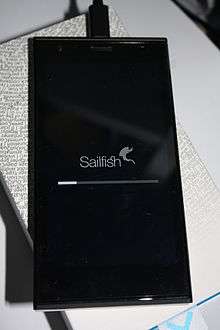Jolla
 | |
|
Osakeyhtiö (Limited company) | |
| Industry | Mobile operating system |
| Predecessor | MeeGo team from Nokia |
| Founded | Pirkkala, Finland (March 29, 2011) |
| Founder |
|
| Headquarters | Tampere, Finland |
Area served | Worldwide |
Key people |
|
| Products | Sailfish OS a Linux-based operating system for mobile devices with roots in the MeeGo project |
Number of employees | 50 employees |
| Website |
jolla |
Jolla Oy[1] (sometimes referred to as Jolla Ltd.) is a Finnish technology company; vendor and developer of Sailfish OS.[2] Headquartered in Tampere, Finland, Jolla has its own research and development offices in Helsinki, Tampere and Cyberport, Hong Kong. Jolla was founded in 2011 by former Nokia staff of the MeeGo project team to use the MeeGo opportunities and its "endless possibilities".
Pronounced 'yolla', the company name is Finnish for dinghy (a small agile boat or life rescue boat) and it refers to the possibility for the company to compete against giants like Samsung and Apple pictured in antithesis as big cruise ships. Then, the community and the media used the name as an ironic joke about the "burning platform" memo, which contained the metaphor "jump into the cold sea water" or "burn with burning platform" used in context of the Nokia business activities.[3]
History

In 2005, Nokia created a new Linux operating system called OS2005, which shipped with the Nokia 770 Internet Tablet. It was renamed Maemo (version 5) and shipped with the Nokia N900 in 2009. An alliance Nokia and Intel merged their Maemo and Moblin (also an open source Linux OS) projects, respectively, into a new project called MeeGo in 2010. Nokia announced that year that the N8 would be the last flagship phone to run Symbian, and "Going forward, N-series devices will be based on MeeGo".[4]
But unexpectedly in 2011 the MeeGo project was declared cancelled no matter whether MeeGo would or wouldn't achieve any success. In compliance with agreements with Intel, only one MeeGo device was released, the Nokia N9, which achieved iconic status.
Despite the N9 market success the MeeGo project in Nokia was already sentenced and a general atmosphere around it was having more and more negative influence on the MeeGo team and other Nokia employees. As a result, in October 2011, some of the MeeGo team left Nokia to form new project of Jolla aimed to develop new opportunities created with the Linux MeeGo OS, using funding from Nokia's "Bridge" program which helps establish and support start-up companies by ex-Nokia employees.[5][6][7]
Nokia at that time was supporting almost all employees leaving the company with €25,000, but Jolla's founders had not been given any rights to patents or other intellectual property to Jolla. Jolla's Sailfish OS, which used middleware core stack of Mer is a direct successor to Nokia and Intel's MeeGo and the Jolla (mobile phone) is successor of N9, however used only the open-sourced components of MeeGo, while the closed-source user interface design (of codename Harmattan) for all future devices had to be developed from scratch. As a result, new mobile standards were established together with Mer.
On 6th July 2012, Jolla announced to the public its intention to develop new smartphones that used a gesture-oriented swipe interface corresponding to former Nokia's Harmattan UI experience. They named their operating system "Sailfish OS", which includes a gesture-based user interface developed using the Qt, QML and HTML5, as did Nokia's N9.
Jolla cooperated with others to grow their application's and MeeGo platform.[8] On 17 September 2013, it announched that their phone will be capable of running Android applications, thanks to the built-in Alien Dalvik. Due to formal limitations, the Google Play Store needed to be installed by end user manually.[9]
On 7 July 2015, after failure of cooperation with Chinese manufacturer on delivery of Jolla Tablet, Jolla announced it would spin out its hardware operations to a brand new company and will continue to focus on current activities as a developer and licensor of the Sailfish OS.[10]
In November 2015, Jolla had to lay off half of its employees due to financial problems caused by delayed financing from investor. On December 21, 2015, after enforced cancelling of Jolla Tablet project, Jolla announced that they would be "shipping a small batch of the Jolla Tablet to early backers during early 2016" which were disposable but "all of our backers will not get a Jolla Tablet"[11] because Chinese manufacturer has sold already produced batch in consequence of delayed financing and it was impossible to produce any next one as essential components were not produced any more. Subsequently, in April 2016, Jolla launched a campaign to refund all the tablet payments that were made during the crowd-sourcing campaign.[12]
After the setbacks with the tablet production, Jolla concentrated on developing the Sailfish mobile operating system. In August 2017, Sailfish X was introduced for the Sony Xperia X smartphone.[13]
Sailfish OS
Operating System
Sailfish OS is an operating system that can be adapted to different mobile devices. Also, the software can be tailored to best fit the consumer needs, from companies to mass consume. It is the core product of Jolla.
Sailfish OS is an evolution of the Nokia MeeGo and Mer project. It is based on Linux open source code powered with C, C++, Qt and QML. The core is developed on Linux kernel that enables a wide hardware support.
Sailfish OS has its own native applications that can be developed and uploaded in the store through the portal harbour.jolla.com. Thanks to Sailfish SDK, developers can fully emulate the whole OS behavior. This, enables the development also for programmers who don’t actually have a Sailfish device. Sailfish application are complemented by the Android ecosystem. Here with Alien Dalvik, 3rd party Android’s applications become compatible with Sailfish.
Sailfish OS has an open core that can be improved by the community but also a proprietary UI that is seen as the succession of the Nokia N9 interface. It is touch-based and the only available interface with true multitasking capabilities. Basic UI applications, like mail, contacts, camera are provided by Jolla and they are under continuous development.
Sailfish OS 1 was launched in December 2013 with the first Jolla phone.
Sailfish OS 2 was implemented in November 2015 for the Jolla Tablet and made compatible for all other products onward.
Sailfish OS 3 is planned for Q3 of 2018 and it will introduce several novelties respect the old version. The new generation of Sailfish OS will be focused on privacy and security as well as extending the support to new hardware. [14]
Sailfish OS products

- Jolla Mobile Phone (November 2013) - smartphone with Sailfish OS, 4.5in IPS qHD display, 16 GB storage, 1 GB RAM, a microSD slot and an 8 MP camera.[16]
- Jolla Tablet (November 2014) - Sailfish OS 2 64-bit Intel's CPU tablet with 7.85 in IPS display, 32GB storage, 2GB RAM, microSD slot, 5 MP main and 2 MP front camera.
- The Other Half - replaceable back cover to the Jolla Phone, which can be used as hardware extension for various purposes. It has NFC and power connection to main smartphone, can have own RAM, CPU, software or hardware, can influence smartphone performance as easy replaceable accessory or extension, e.g. change appearance and ambience settings, or connect the hardware keyboard.
- Jolla C Mobile Phone (May 2016) - smartphone with Sailfish OS 5.0in IPS HD display, 16 GB storage, 2 GB RAM, a microSD slot and an 8 MP camera.[17]
- Aqua Fish, by Intex in July 2016 – Sailfish OS, 2 GB RAM, 16 GB storage, 5.0-inch display, microSD slot and 8 MP camera. [18]
- Turing Phone, by TRI in 2016 – Sailfish OS, 3 GB RAM, 16, 64 or 128 GB built-in memory, 5.5-inch HD display, 13 MP back camera and 8 MP front camera.[19]
- R7, by INOI in February 2017 – Sailfish OS, dual SIM smartphone with both GPS and GLONASS navigation capabilities, 2GB RAM, 16GB internal memory, microSD up to 64GB, 5.0-inch screen, 5 MP front camera, presented at the Congress in February 2017.[20]
- Accione, by Jala in October 2017 – Sailfish OS, 2 GB RAM, 16 GB internal memory, microSD up to 128 GB, 5.0-inch display, quadcore.
- Accione P, by Jala in October 2017– Sailfish OS, 3 GB RAM, 32 GB internal memory, microSD up to 128 GB, 5.0-inch display, octa-core.[21]
- Sony Xperia X in October 2017- Sailfish OS, single SIMsim, microSD up to 200 GB, 5” full HD display, 13 MP front camera.[22]
- Gemini, by Planet Computers in January 2018– Sailfish OS, 4G and WLAN, full physical keyboard, 5.99-inch screen, 5 MP camera and stereo speakers.[23]
Sailfish community
A community of developers actively works with Jolla in order to upgrade more and more Sailfish OS to achieve the best possible user experience. This development is structured in the following complementary parts:
- Apps development: The harbour.jolla.com web site is where developers can submit their works, and manage their work in the Jolla Store. Then, Sailfish users' can install available applications from the store directly on their devices. The Jolla Harbour and Jolla Store support only free applications.[24]
- Core platform development: Instruction and discussion on core platform development are collected in sailfish.org. Members of the community can help improving the core platform in real time as Jolla’s developers are working on it.[25]
- HW adaptation: The community can port Sailfish OS in order to integrate it in a new device with the guidance available in sailfishos.org. Hardware Adaptation development is about working with device bootloaders, configuring and building the Linux kernel, low level Android systems, low level Linux systems, C, C++ and shellscript coding, debugging and working blind.[26]
- Translations contribution: Thanks to the help of community members the Sailfish OS is available at least in thirty language, such as: Chinese, several Indian languages all European ones.[27]
- Forum discussion: The together.jolla.com is a forum where Sailfish OS users and developers can interact with Jolla in order have feedback, share instructions, vote for new development areas. [28]
See also
- Jolla C
- Jolla (smartphone)
- Jolla Tablet
- Sailfish OS
- Nokia N9
- Nokia N900
- MeeGo
- Aqua Fish
- INOI R7
- Liquidmorphium Turing Phone
- INOI
- Accione
- Sony Xperia X
- Gemini (PDA)
References
- ↑ "Jolla Oy", Business Information System, the Finnish National Board of Patents and Registration, and the Finnish Tax Administration, archived from the original on July 18, 2012, retrieved July 18, 2012
- ↑ Jolla at LinkedIn. "LinkedIn". LinkedIn. LinkedIn. Retrieved 10 November 2013.
- ↑ Zieler, Chris. "Who wants to be the mobile of Google, not Nokia". Retrieved 12 October 2012.
- ↑ "Nokia picks MeeGo over Symbian for iPhone rival".
- ↑ "Many former Nokia employees start businesses of their own", Helsingin Sanomat, archived from the original on February 9, 2014
- ↑ Lunden, Ingrid. "Nokia Bridge: Nokia's Incubator Gives Departing Employees €25k And More To Pursue Ideas That Nokia Has Not". techcrunch.com. techcrunch.com. Retrieved 7 June 2013.
- ↑ Tung, Liam. "Inside Nokia Bridge: How Nokia funds ex-employees' new start-ups". zdnet.com. © 2013 CBS Interactive. Retrieved 7 June 2013.
- ↑ Davies, Chris. "Jolla Mobile CEO: "MeeGo is not dead"". slashgear.com. SlashGear. Retrieved 19 August 2012.
- ↑ "Jolla Sailfish OS Andriod Support". The Register. Retrieved 15 December 2013.
- ↑ "Mobile Maker Jolla Splits In Two, With Sailfish OS Its First Order Of Business". TechCrunch. Retrieved 8 July 2015.
- ↑ "New Year's Greetings from Jolla".
- ↑ "New Year's Greetings from Jolla". 25 May 2016. Retrieved 31 December 2017.
- ↑ "Introducing Sailfish X and all the details you want to know". 25 August 2017. Retrieved 31 December 2017.
- ↑ "Sailfish OS about".
- ↑ "MoMo Helsinki – May 20th – Featuring Jolla Love Day". Mobile Monday. Archived from the original on April 8, 2014. Retrieved 2014-02-18.
- ↑ https://www.youtube.com/watch?v=lfAixpkzcBQ
- ↑ https://jolla.com/jollac
- ↑ https://www.youtube.com/watch?v=m4AFwVLd1r4
- ↑ https://www.phonearena.com/news/The-Turing-Phone-is-back-as-worlds-first-mass-produced-Liquidmorphium-smartphone_id93052
- ↑ https://4pda.ru/2017/02/20/336158?salt=1487649009102
- ↑ http://accione.com/
- ↑ https://jolla.com/sailfishx/
- ↑ https://blog.jolla.com/gemini/
- ↑ https://sailfishos.org/wiki/Application_Development
- ↑ https://sailfishos.org/wiki/Platform_Development
- ↑ https://sailfishos.org/wiki/Hardware_Adaptation_Development_Kit
- ↑ https://sailfishos.org/wiki/Translate_the_OS
- ↑ https://together.jolla.com/questions/
External links
- Official website
- Template:Sailfish OS
